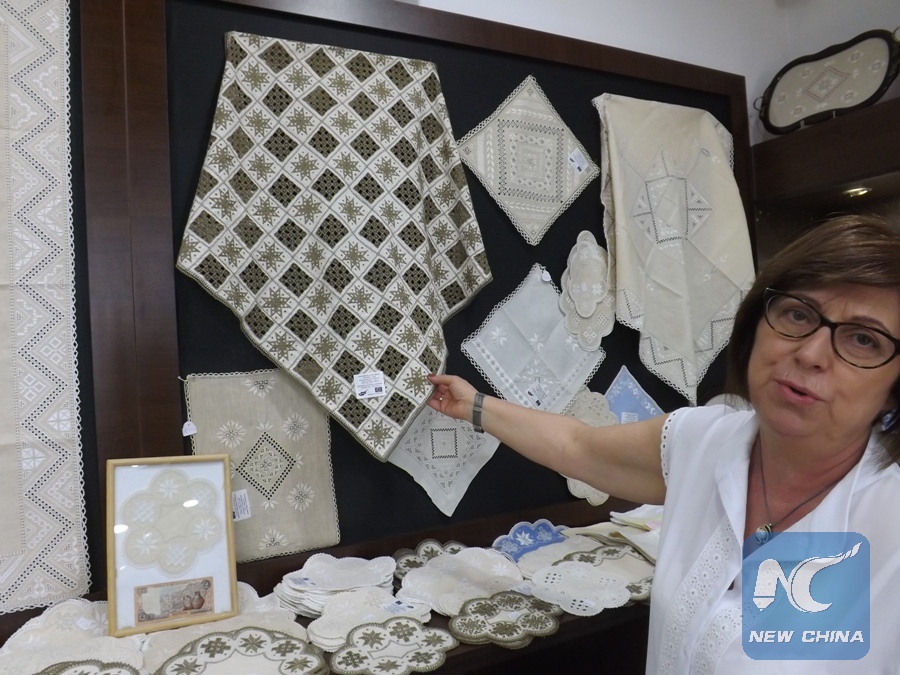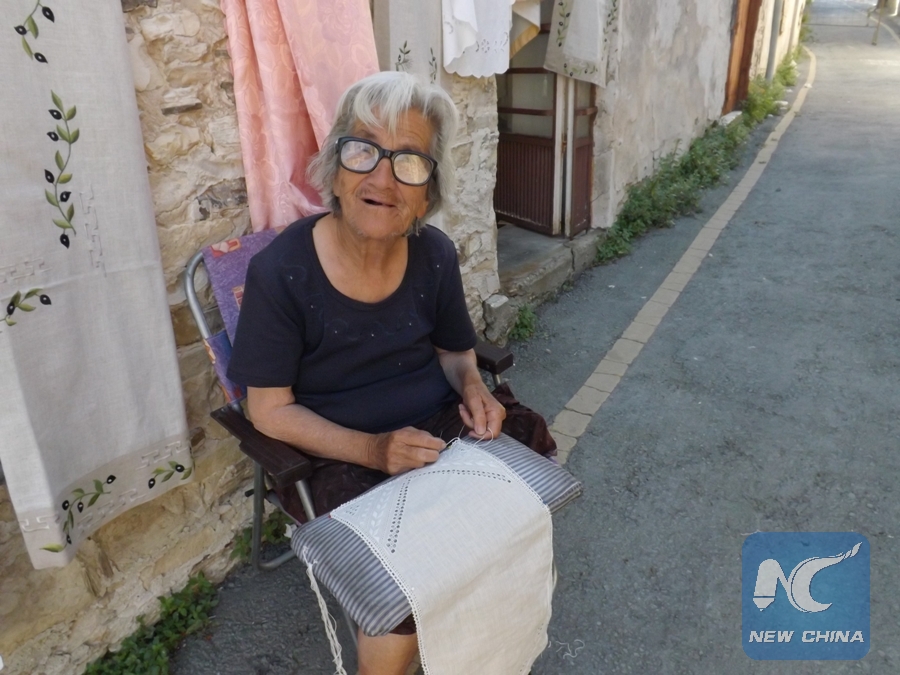
Andri Hadjiadamou, local craft shop owner, is showing different types of Lefkara lace in her shop. (Xinhua/Nathan Morley)
by Nathan Morley
NICOSIA, July 22 (Xinhua) -- In the foothills of the Troodos Mountains, sits a picturesque village renowned for its exquisite lace embroidery. But, after centuries of booming trade, this traditional craft is under threat from a dwindling workforce.
With an aging population, the village of Lefkara, south of the capital Nicosia, fears that their uniquely Cypriot lace may soon face extinction.
"We cannot find the ladies to make the lace; they are getting less and less," Andri Hadjiadamou, a local craft shop owner told Xinhua. "The young generation doesn't stay in the village anymore."
Villagers have been crafting these distinctive pieces for centuries -- it's a craft which requires patience, concentration, and precision. Hadjiadamou says the elderly embroiders that create laces, one stitch at a time, are a dying generation, and there is nobody that wants to replace them.
Modern Cyprus, it seems, is not much fussed about this old tradition. It's painstaking work with no incentive, according to councilor Kyriacos Papaloizou. He says attendance at workshops where the ladies taught the younger generation their skills have been disappointing, and this centuries-old craft is at serious risk of no longer being practiced.
"This sort of trade - this handicraft work - it's out of fashion, therefore the majority of younger ladies do not show interest towards the production," he told Xinhua. "Another major disadvantage is that nowadays everybody and especially the ladies, they want to get educated, and by getting an education they want to proceed and do something else."
Up until the mid-1960s, demand for the lace grew to such an extent that most locals devoted their entire time to needle-work. One of them, pensioner Androulla is still blessed with the skills to create lace masterpieces.
She started learning the craft in the 1940s when she was just eight years old. She was one of the hundreds of skilled women that Lefkara once depended on, now the tradition is kept alive by just a handful of pensioners. "I've been doing this all my life. Five hours in this chair every day," she says.
The creations, known locally as Lefkaritika, are sewn into unbleached Irish or English linen cloths, with a pattern of stitches running around the border.

Pensioner embroiderer Androulia is sitting in her chair with a piece of unfinished Lefkara lace embroidery. (Xinhua/Nathan Morley)
For years, elderly ladies sitting in groups in the backstreets and doorways, chatting while making exquisite lace creations was a common sight. Now Androulla sits alone, but she still works with tremendous skill as she sews filigree patterns into a tablecloth, whilst describing how Leonardo da Vinci once purchased some local handiwork during a visit to Lefkara in 1481. Apparently, he was so impressed with the embroidery that he also painted it into his Last Supper.
"Irish linen and French cotton - this is a Leonardo da Vinci design, from the Milan Cathedral Church," Androulla explains, pointing to the pattern named after the artist. "Before 500-years, one tablecloth - a big one, went to the Milano Cathedral."
Even now, people still come from all over Europe to buy Lefkara designs. A day rarely goes by without coach-loads of tourists stopping for shopping, but it was in the 1950s when Americans travelling through Cyprus became the big spending customers.
And in today's increasingly virtual world, some customers buy online. "For the lace, it's mostly Americans and English. They order online, or they come over for holidays and they buy, they love our culture," says Andri Hadjiadamou. "The lace is more expensive now, one piece might start from 20 euros, and we have tablecloths priced over 6 to 7 thousand euros. So it's more expensive to buy, we don't sell so much."
Kyriacos talks passionately about the craft. For him, the prospect of losing a skill handed down from medieval times is heartbreaking. "In a few years, mathematically speaking, we won't be able to have a lady to make those things. So that's the real problem," he says.
"Some of the designs we used to do in the past are not made anymore because the ladies that used to teach and make them have passed away. If we continue like that, defiantly in a few years' time, it will be fully extinct."
In 2009, UNESCO added Lefkara laces to their list of intangible cultural heritage.

